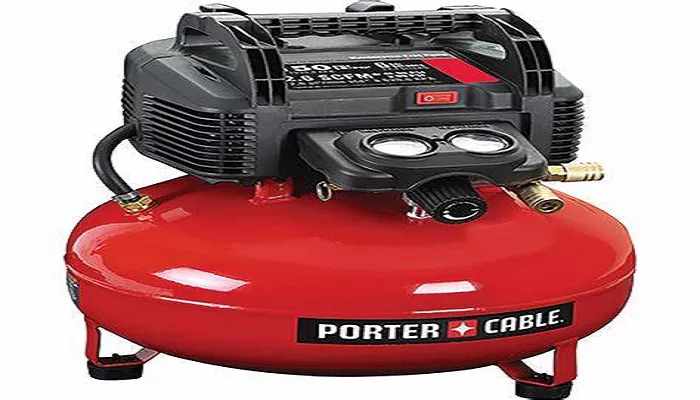A pancake air compressor is a popular type of portable air compressor widely used in construction, automotive repair, woodworking, and DIY projects. Its compact, flat design—resembling a pancake—makes it easy to transport and store while delivering sufficient compressed air for various pneumatic tools.
Overview of Pancake Air Compressors
Pancake air compressors belong to the category of single-stage, oil-free, reciprocating (piston) compressors. They are typically powered by an electric motor and are designed for intermittent use, making them ideal for small to medium-duty tasks.
Key Characteristics
- Compact and lightweight (usually under 30 lbs)
- Oil-free pump (requires less maintenance)
- Low to moderate CFM (Cubic Feet per Minute) output (suitable for nail guns, inflatables, and light spraying)
- Portable with a built-in handle
- Pancake-shaped air tank (typically 3 to 6 gallons)
Main Components of a Pancake Air Compressor
Electric Motor
- Provides the power to drive the piston.
- Most pancake compressors use induction motors (120V or 240V).
- The motor is connected to the crankshaft via a belt or direct drive.
Pump (Compression Mechanism)
- The piston-cylinder assembly compresses air.
- Uses single-stage compression (air is compressed once before storage).
- Oil-free design (Teflon-coated or composite rings reduce friction).
Air Tank (Storage Reservoir)
- Stores compressed air for on-demand use.
- Made of steel or aluminum to withstand high pressure.
Pressure Switch
- Automatically turns the motor on/off based on tank pressure.
- Cut-in pressure (minimum pressure to restart motor).
- Cut-out pressure (maximum pressure before shutdown).
Pressure Gauge
- Displays tank pressure (PSI).
- Some models include a second gauge for output pressure.
Regulator Valve
- Adjusts the output pressure for different tools.
Safety Valve (Pressure Relief Valve)
- Releases air if pressure exceeds safe limits.
Check Valve
- Prevents backflow of compressed air into the pump when the motor stops.
Air Outlet & Quick-Connect Coupler
- Allows attachment of hoses and pneumatic tools.
Step-by-Step Working Principle
Now, let’s examine how these components work together to deliver compressed air.
Step 1: Power On & Initialization
- When plugged in, the motor starts (if tank pressure is below the cut-in level).
Step 2: Air Intake
- The piston moves downward, creating a vacuum in the cylinder.
- The intake valve opens, allowing atmospheric air to enter.
Step 3: Compression Phase
- The piston moves upward, compressing the trapped air.
- The intake valve closes, and pressure builds inside the cylinder.
Step 4: Discharge into the Tank
- Once pressure exceeds the tank’s stored pressure, the discharge valve opens.
- Compressed air flows into the storage tank.
Step 5: Pressure Cut-Off
- When the tank reaches the cut-out pressure, the pressure switch stops the motor.
Step 6: Air Delivery to Tools
- When a tool is connected, the regulator controls airflow.
- The check valve ensures air does not flow backward into the pump.
Step 7: Motor Restart (If Needed)
- As air is used, tank pressure drops.
- At the cut-in pressure, the motor restarts to refill the tank.
Advantages of Pancake Air Compressors
Portability
- Lightweight and easy to carry.
Low Maintenance
- Oil-free design eliminates the need for lubrication.
Quiet Operation
- Generally quieter than larger industrial compressors.
Quick Recovery Time
- Small tank size means faster refill cycles.
Ideal for Intermittent Use
- Perfect for nail guns, staplers, and inflating tires.
Limitations
Limited CFM Output
- Not suitable for high-demand tools like sanders or grinders.
Small Tank Capacity
- Frequent motor cycling if used continuously.
Common Applications
- Nailing & Stapling (Framing nailers, brad nailers)
- Inflating Tires & Sports Equipment
- Light Spray Painting
- Blowing Dust & Debris
- Pneumatic Staple Guns (Upholstery, Carpentry)
Maintenance Tips
- Drain moisture from the tank regularly.
- Check for leaks in hoses and fittings.
- Clean air filters to ensure proper airflow.
- Inspect safety valves periodically.
Conclusion
A pancake air compressor operates on simple yet efficient mechanical principles, making it a versatile tool for light-duty pneumatic applications. Its compact design, ease of use, and low maintenance make it a favorite among DIYers and professionals alike.
Understanding its working mechanism helps users maximize efficiency, prolong lifespan, and choose the right model for their needs. Whether for construction, automotive, or home projects, the pancake air compressor remains a reliable and portable solution for compressed air demands.

